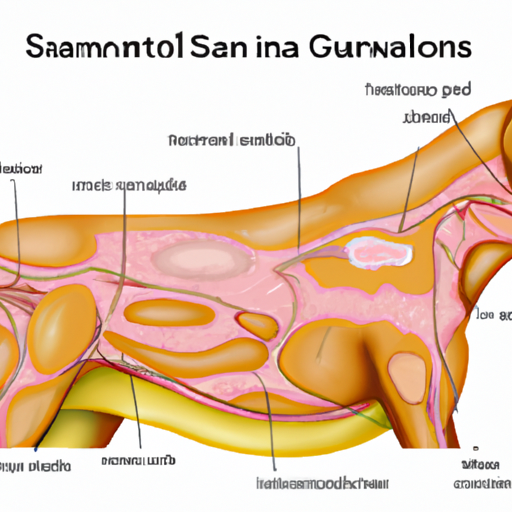As a pet owner, you’ve probably noticed that your dog doesn’t sweat the way you do. This doesn’t mean your furry friend can’t cool down. Dogs have a unique system for regulating their body temperature, and it’s centered around the location of their sweat glands.
Table of Contents
- Canine Sweat Glands: An Overview
- The Role of Panting in Canine Thermoregulation
- How Dogs Sweat Through Their Paws
- Frequently Asked Questions
Key Takeaways
- Dogs have sweat glands, but they are located in different areas than humans.
- Panting is a primary method dogs use to cool down.
- Dogs also sweat through their paws.
Canine Sweat Glands: An Overview
Dogs have two types of sweat glands: merocrine glands and apocrine glands. Merocrine sweat glands, similar to human sweat glands, are located in a dog’s paw pads. These glands are active when a dog is hot and need to cool down. Apocrine glands, on the other hand, are located all over the dog’s body. However, instead of producing sweat for cooling, these glands emit pheromones for communication with other dogs.
You can learn more about these glands and their functions on PetMD.
The Role of Panting in Canine Thermoregulation
Though dogs do have sweat glands, they don’t rely on sweating as their primary means of cooling down like humans do. Instead, dogs primarily cool themselves through panting.
When a dog pants, it breathes quickly, allowing moisture to evaporate from the tongue, upper throat, and lungs, resulting in a cooling effect. This is why you might find your dog panting after a vigorous game of fetch or during a hot summer day. Through panting, dogs can effectively regulate their body temperature and maintain a safe internal environment.
For more in-depth information about why dogs pant, check out this article on OneTopDog.
How Dogs Sweat Through Their Paws
While panting does the majority of the cooling work, dogs also sweat through their paw pads. When your dog is overheated, the merocrine sweat glands in their paws will secrete a watery sweat. You may notice this when you see wet paw prints on a hot day.
This type of sweating is not as effective in cooling dogs down as panting, but it does play a role in their overall thermoregulation. If you’ve ever noticed your dog leaving damp paw prints, that’s a telltale sign of doggy sweat!
You can find some interesting facts about dog paws on OneTopDog.
Frequently Asked Questions
-
Do dogs sweat from their tongues?
No, dogs do not sweat from their tongues. They cool down by panting, which allows moisture to evaporate from their tongues, but this is not the same as sweating. -
Why don’t dogs sweat like humans?
Dogs’ sweat glands are mostly located in their paw pads, and these glands are not as plentiful or as efficient as human sweat glands. That’s why dogs rely more on panting to cool down. -
What are the signs of a dog overheating?
Signs of overheating can include excessive panting or drooling, increased heart rate, and lethargy. If you suspect your dog is overheating, you should move them to a cool area and provide plenty of water. -
Can dogs sweat under their fur?
Dogs do not sweat under their fur. The apocrine glands located under their fur secrete pheromones, not sweat. -
How can I help my dog cool down on a hot day?
Provide plenty of fresh water for your dog and make sure they have a cool, shaded place to rest. Limit exercise during the heat of the day, and consider using cooling mats or kiddie pools for your dog to chill out in.
Remember, understanding your dog’s natural cooling mechanisms helps you care for them better, especially in warmer weather. For more tips on caring for your dog in hot weather, visit OneTopDog. Hopefully, this guide to where dogs’ sweat glands are located and how they help your pup stay cool has been helpful!



